Comparative Analysis of the Effects of Hydroxysafflor Yellow A and Anhydrosafflor Yellow B in Safflower Series of Herb Pairs Using Prep-HPLC and a Selective Knock-Out Approach
Abstract
:1. Introduction
2. Results and Discussion
2.1. The Knock-Out Results of Preparative HPLC
2.2. Effect of PAF-Induced Platelet Aggregation
2.3. Effect of AA-Induced Platelet Aggregation
2.4. Effect of Anticoagulation
2.5. Integration of Activating Blood Circulation Effect with Multi-Index Comprehensive Index Method
3. Materials and Methods
3.1. Plant Materials
3.2. Instrumentation
3.3. Chemicals and Reagents
3.4. Animals
3.5. Preparation of Herb Pair Samples
3.6. Preparation of Safflower Series of Herb Pairs Knock Out HSYA or ASYB
3.7. Evaluation of the Antiplatelet Aggregation and Anticoagulation Activities in Vitro
3.7.1. Sample Preparation
3.7.2. Detection of Antiplatelet Aggregation
3.7.3. Determination of Blood Coagulation Function (TT, PT, APTT)
3.7.4. Statistical Analysis
4. Conclusions
Supplementary Materials
Acknowledgments
Author Contributions
Conflicts of Interest
References
- Wang, L.Y.; Tang, Y.P.; Liu, X.; Zhu, M.; Tao, W.W.; Li, W.X.; Duan, J.A. Effects of ferulic acid on antioxidant activity in Angelicae Sinensis Radix, Chuanxiong Rhizoma, and their combination. Chin. J. Nat. Med. 2015, 13, 401–408. [Google Scholar] [CrossRef]
- Normile, D. Asian medicine: The new face of traditional Chinese medicine. Science 2003, 299, 188–190. [Google Scholar] [CrossRef]
- Xue, T.H.; Roy, R. Studying traditional Chinese medicine. Science 2003, 300, 740–741. [Google Scholar] [CrossRef]
- Keith, C.T.; Borisy, A.A.; Stockwell, B.R. Multicomponent therapeutics for networked systems. Nat. Rev. Drug Discov. 2005, 4, 71–78. [Google Scholar] [CrossRef]
- Li, X.J.; Zhang, H.Y. Synergy in natural medicines: Implications for drug discovery. Trends Pharmacol. Sci. 2008, 29, 331–332. [Google Scholar] [CrossRef]
- He, Y.; Gai, Y.Q.; Wu, X.B.; Wan, H.T. Quantitatively analyze composition principle of Ma Huang Tang by structural equation modeling. J. Ethnopharmacol. 2012, 143, 851–858. [Google Scholar] [CrossRef]
- Li, W.X.; Tang, Y.P.; Qian, Y.F.; Shang, E.X.; Wang, L.Y.; Zhang, L.; Su, S.L.; Duan, J.A. Comparative analysis of main aromatic acids and phthalides in Angelicae Sinensis Radix, Chuanxiong Rhizoma, and Fo-Shou-San by a validated UHPLC-TQ-MS/MS. J. Pharm. Biomed. Anal. 2014, 99, 45–50. [Google Scholar] [CrossRef]
- Wang, S.P.; Hu, Y.Y.; Tan, W.; Wu, X.; Chen, R.E.; Cao, J.L.; Chen, M.W.; Wang, Y.T. Compatibility art of traditional Chinese medicine: From the perspective of herb pairs. J. Ethnopharmacol. 2012, 143, 412–423. [Google Scholar] [CrossRef]
- Jin, Y.; Qu, C.; Tang, Y.P.; Pang, H.Q.; Liu, L.L.; Zhu, Z.H.; Shang, E.X.; Huang, S.L.; Sun, D.Z.; Duan, J.A. Herb pairs containing Angelicae Sinensis Radix (Danggui): A review of bio-active constituents and compatibility effects. J. Ethnopharmacol. 2016, 181, 158–171. [Google Scholar] [CrossRef]
- Yue, S.J.; Tang, Y.P.; Xu, C.M.; Li, S.J.; Zhu, Y.; Duan, J.A. Two New Quinochalcone C-Glycosides from the Florets of Carthamus tinctorius. Int. J. Mol. Sci. 2014, 15, 16760–16771. [Google Scholar] [CrossRef]
- Zhou, X.D.; Tang, L.Y.; Xu, Y.L.; Zhou, G.H.; Wang, Z.J. Towards a better understanding of medicinal uses of Carthamus tinctorius L. in traditional Chinese medicine: A phytochemical and pharmacological review. J. Ethnopharmacol. 2014, 151, 27–43. [Google Scholar] [CrossRef]
- Li, W.X.; Tang, Y.P.; Shi, X.Q.; Guo, J.M.; Liu, P.; Duan, J.A. Research on Chinese medicine pairs (IV)—their compatibility effects. Chin. J. Chin. Mater. Med. 2013, 38, 4203–4207. [Google Scholar]
- Zhu, M.; Tang, Y.P.; Duan, J.A.; Guo, J.M.; Guo, S.; Su, S.L.; Shang, E.X.; Qian, D.W.; Ding, A.W. Roles of paeoniflorin and senkyunolide I in SiWu decoction on antiplatelet and anticoagulation activities. J. Sep. Sci. 2010, 33, 3335–3340. [Google Scholar] [CrossRef]
- Wang, L.Y.; Tang, Y.P.; Liu, X.; Ge, Y.H.; Li, S.J.; Shang, E.X.; Duan, J.A. Study on material base of Carthamus tinctorius with antioxidant effect based on selective knock-out. Chin. J. Chin. Mater. Med. 2014, 39, 1285–1289. [Google Scholar]
- Steinhubl, S.R.; Moliterno, D.J. The role of the platelet in the pathogenesis of atherothrombosis. Am. J. Cardiovasc. Drug. 2005, 5, 399–408. [Google Scholar] [CrossRef]
- Hosford, D.; Braquet, P. Antagonists of platelet activating factor: Chemistry, pharmacology and clinical applications. Prog. Med. Chem. 1990, 27, 325–380. [Google Scholar]
- Wang, Q.Y.; Dong, L.; Wang, M.L.; Chen, G.L. Research progress of the PAF receptor antagonists. J. Shenyang Pharm. Univ. 2011, 28, 245–252. [Google Scholar]
- Tazawa, R.; Green, E.D.; Ohashi, K.; Wu, K.K.; Wang, L.H. Characterization of the complete genomic structure of human thromboxane syntheses gene and functional analysis of its promoter. Arch. Biochem. Biophys. 1996, 34, 349–356. [Google Scholar] [CrossRef]
- Wang, X.M.; Zhang, Z.S.; Yao, Z.Y.; Zhao, M.X. Sulfation, anticoagulant and antioxidant activities of polysaccharide from green algae Enteromorpha linza. Int. J. Biol. Macromol. 2013, 58, 225–230. [Google Scholar] [CrossRef]
- Li, W.X.; Tang, Y.P.; Shang, E.X.; Guo, J.M.; Huang, M.Y.; Qian, D.W.; Duan, J.A. Analysis on correlation between general efficacy and chemical constituents of Danggui-Chuanxiong herb pair based on artificial neural network. Chin. J. Chin. Mater. Med. 2012, 37, 2935–2942. [Google Scholar]
- Fan, L.; Zhao, H.Y.; Xu, M.; Zhou, L.; Guo, H.; Han, J.; Wang, B.R.; Guo, D.A. Qualitative evaluation and quantitative determination of 10 major active components in Carthamus tinctorius L. by high-performance liquid chromatography coupled with diode array detector. J. Chromatogr. A 2009, 1216, 2063–2070. [Google Scholar] [CrossRef]
- Kazuma, K.; Takahashi, T.; Matsumoto, T.; Sato, K.; Takeuchi, H.; Okuno, T. Quinochalcones and flavonoids from fresh florets in different clutivars of Carthamus tinctorius L. Biosci. Biotech. Bioch. 2000, 64, 1588–1599. [Google Scholar] [CrossRef]
- Ashida, S.I.; Abiko, Y. Inhibition of platelet aggregation by a new agent, Ticlopidine. Thromb. Haemost. 1979, 40, 542–550. [Google Scholar]
- Song, Z.H.; Ji, Z.N.; Lo, C.K.; Dong, T.X.; Zhao, K.J.; Li, O.T.; Haines, C.J.; Kung, S.D.; Tsim, K.W. Chemical and biological assessment of a traditional Chinese herbal decoction prepared from Radix Astragali and Radix Angelicae Sinensis: Orthogonal array design to optimize the extraction of chemical constituents. Planta Med. 2004, 70, 1222–1227. [Google Scholar] [CrossRef]
- Li, W.X.; Tang, Y.P.; Guo, J.M.; Huang, M.Y.; Qian, D.W.; Duan, J.A. Comparative assessing the effects of Angelica Root and Chuanxiong on the hemorheology and the blood coagulation function in acute blood stasis rats. Chin. J. Integr. Tradit. West. Med. 2012, 32, 806–811. [Google Scholar]
- Wang, X.J.; Zhang, A.H.; Zhou, X.H.; Liu, Q.; Nan, Y.; Guan, Y.; Kong, L.; Han, Y.; Sun, H.; Yan, G.L. An integrated chinmedomics strategy for discovery of effective constituents from traditional herbal medicine. Sci. Rep. 2016, 6, 18997. [Google Scholar] [CrossRef]
- Sample Availability: Samples of the compounds HSYA and ASYB are available from the authors.
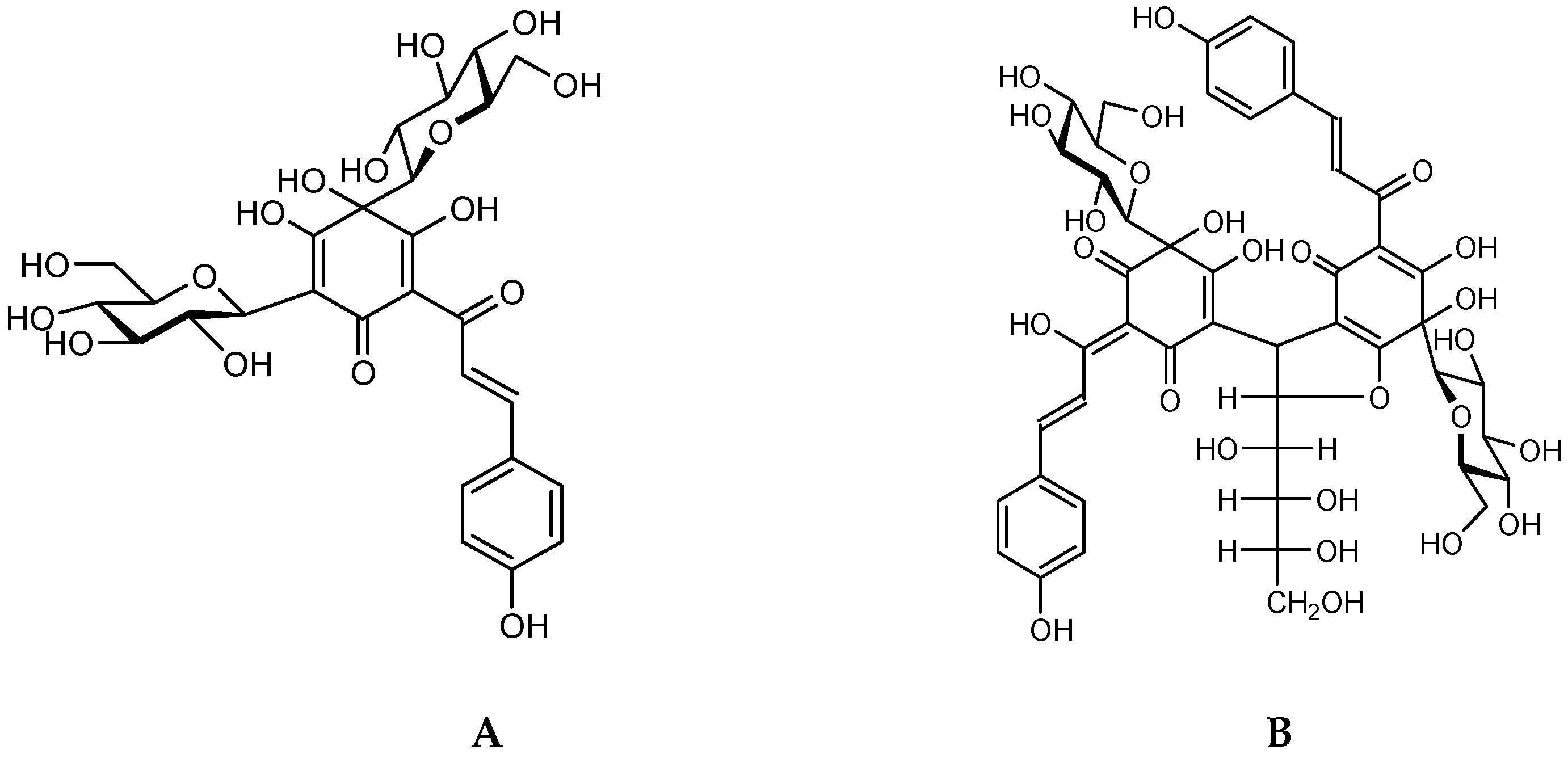
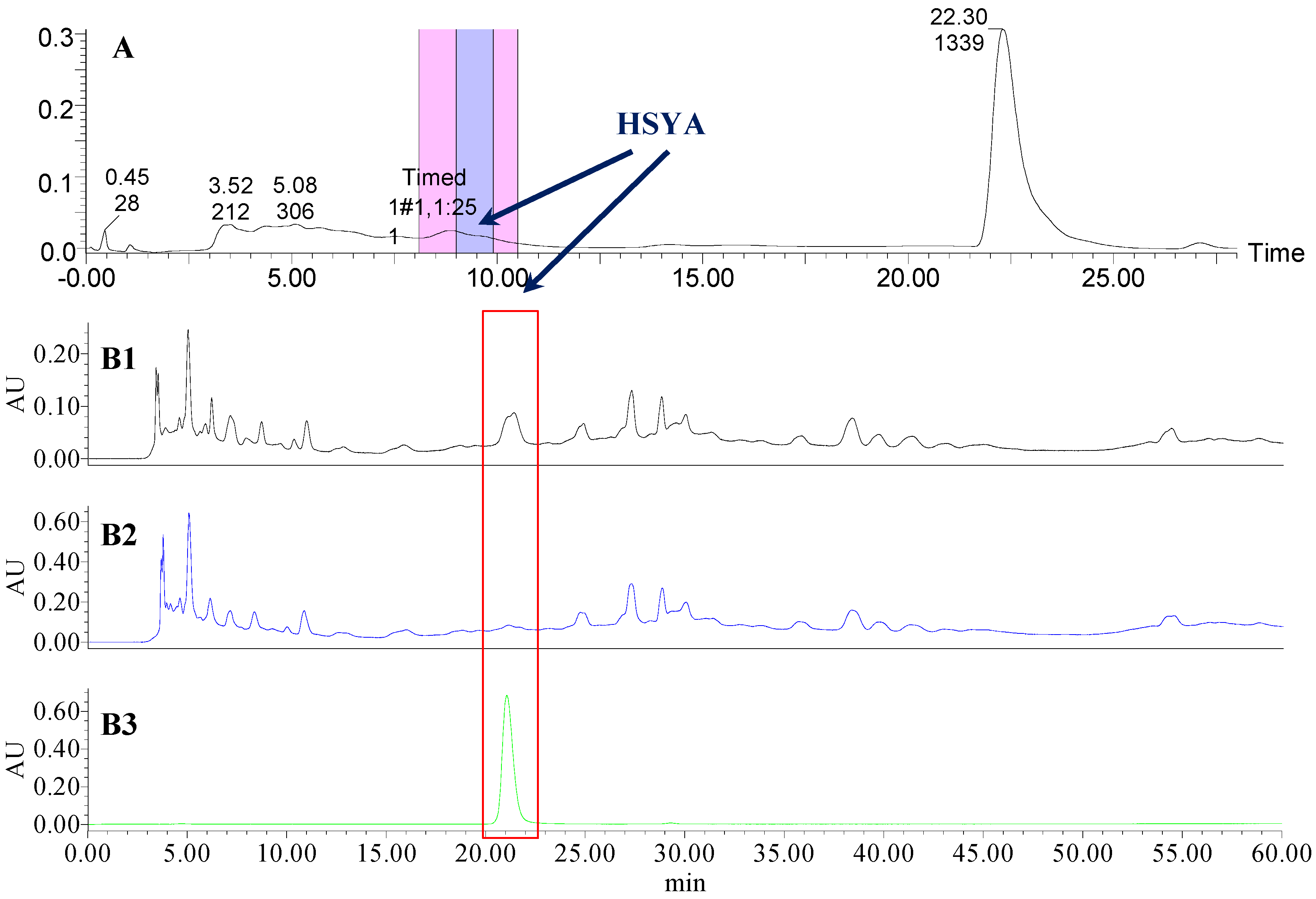
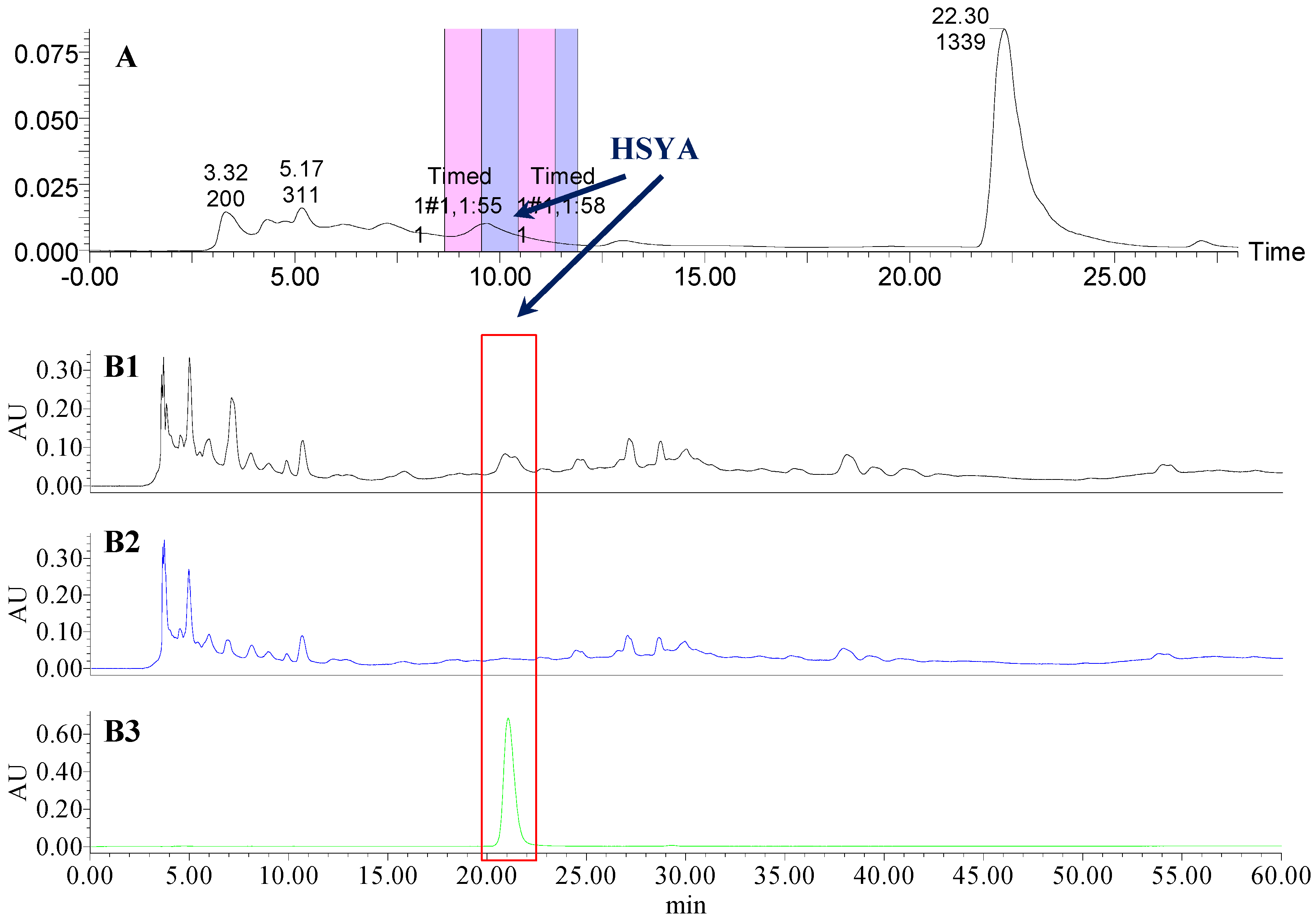
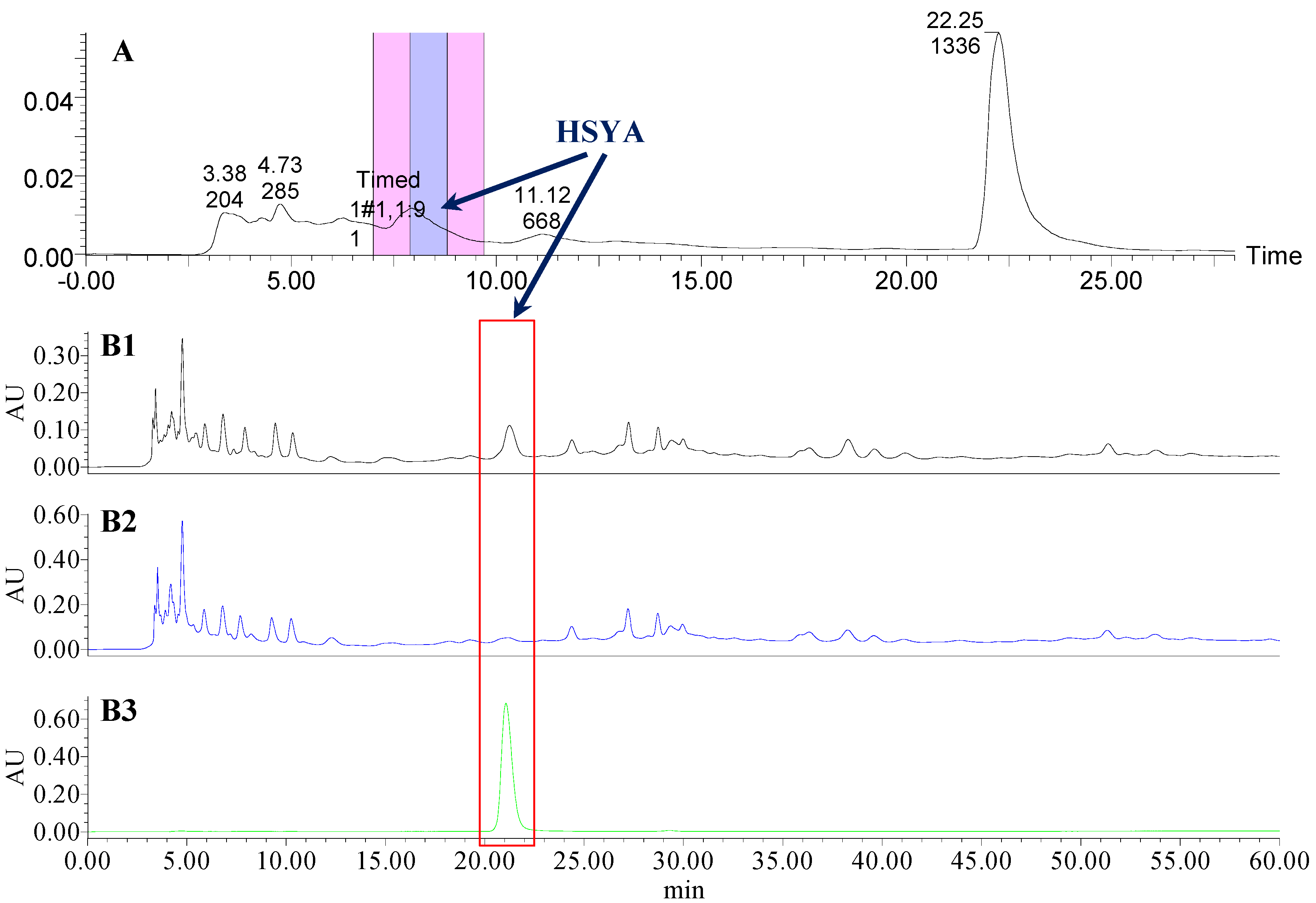
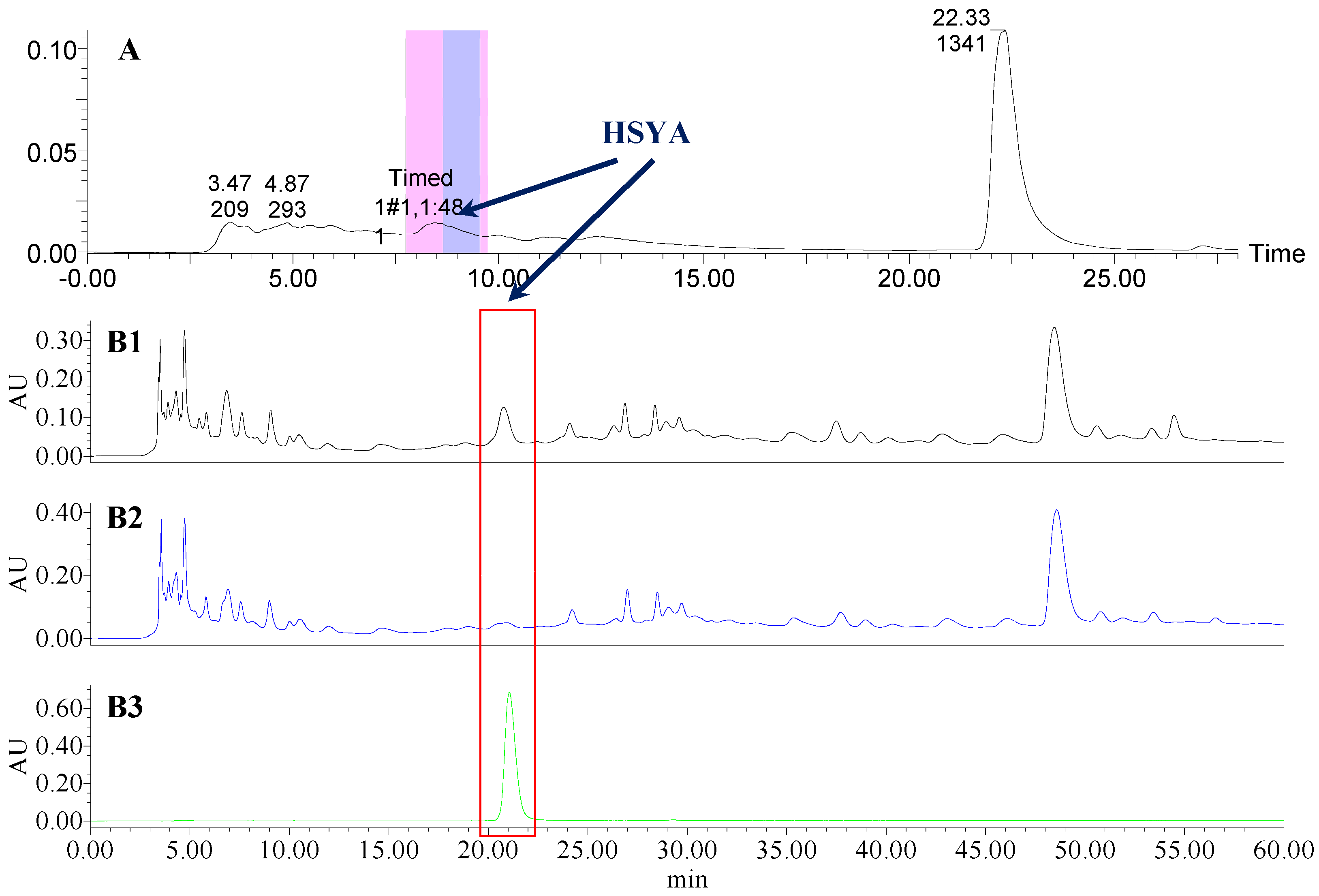

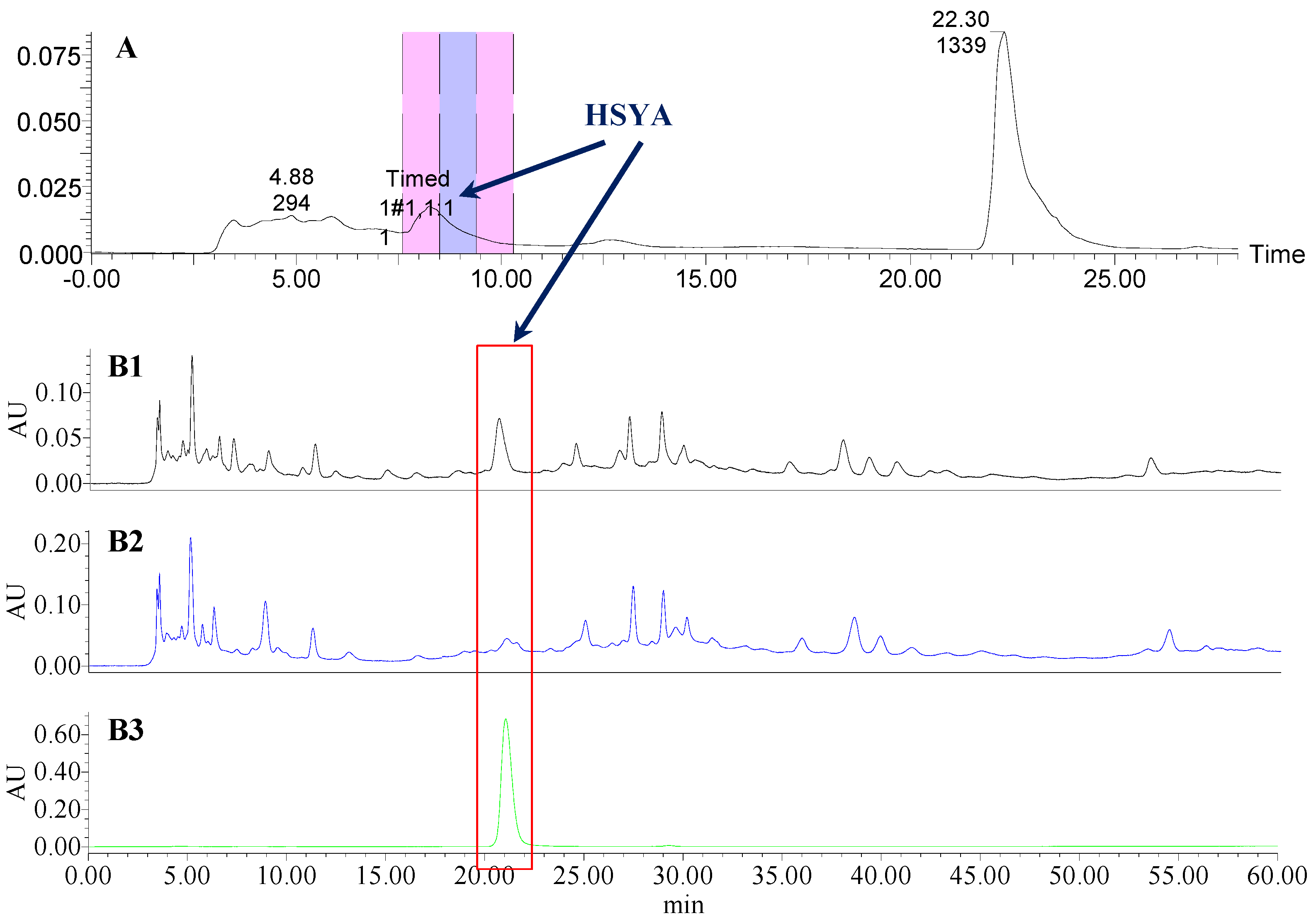
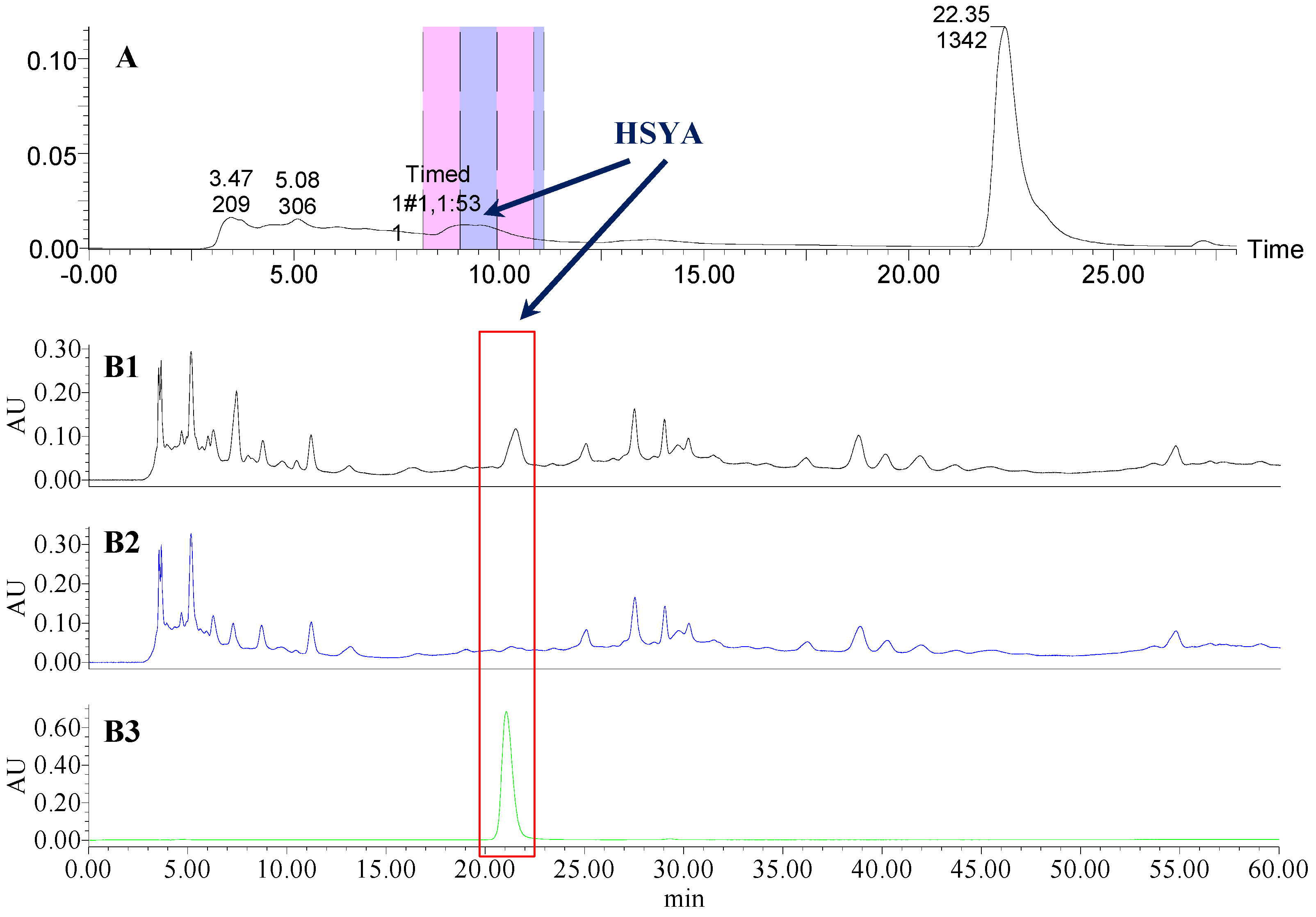

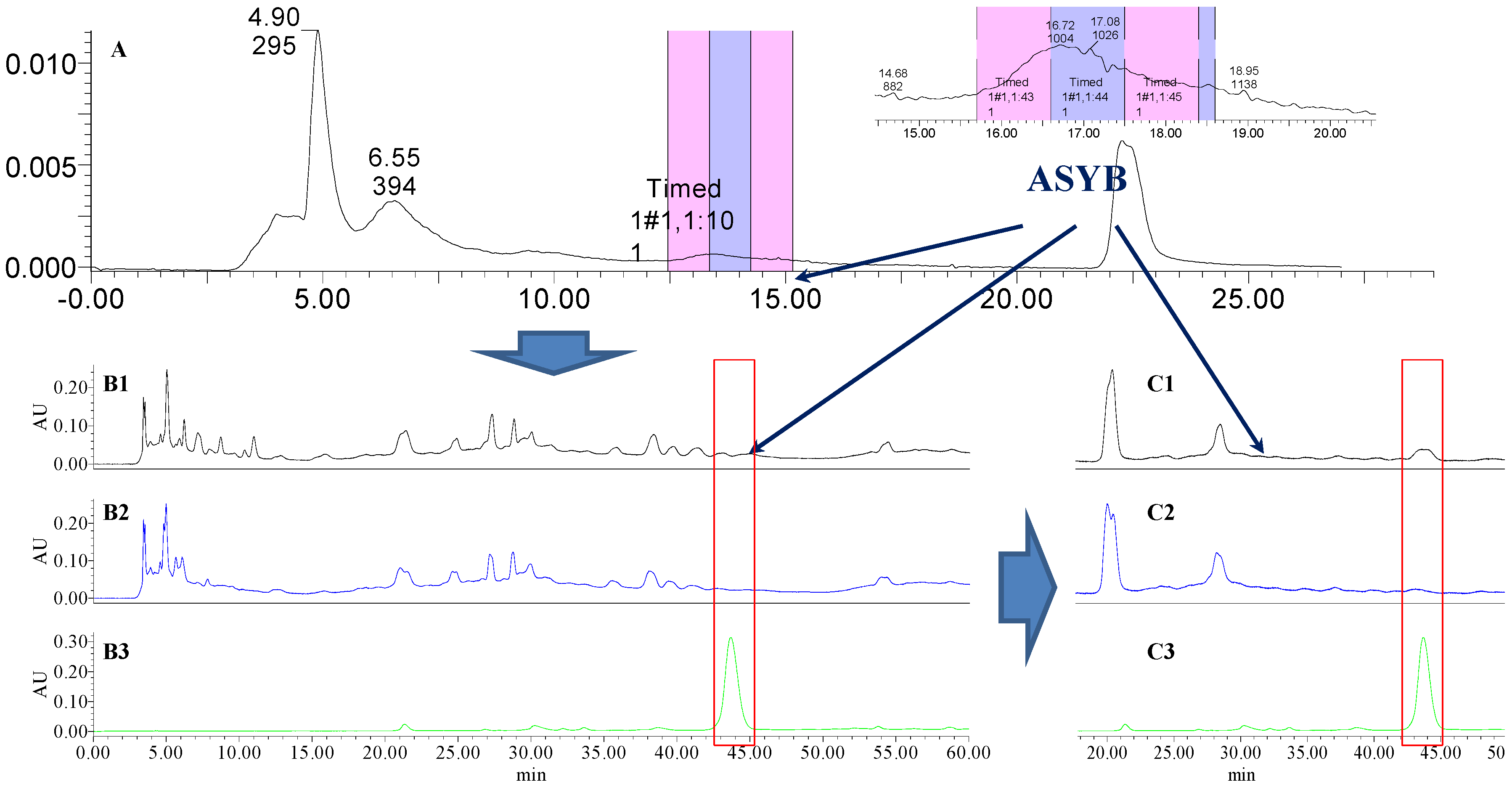
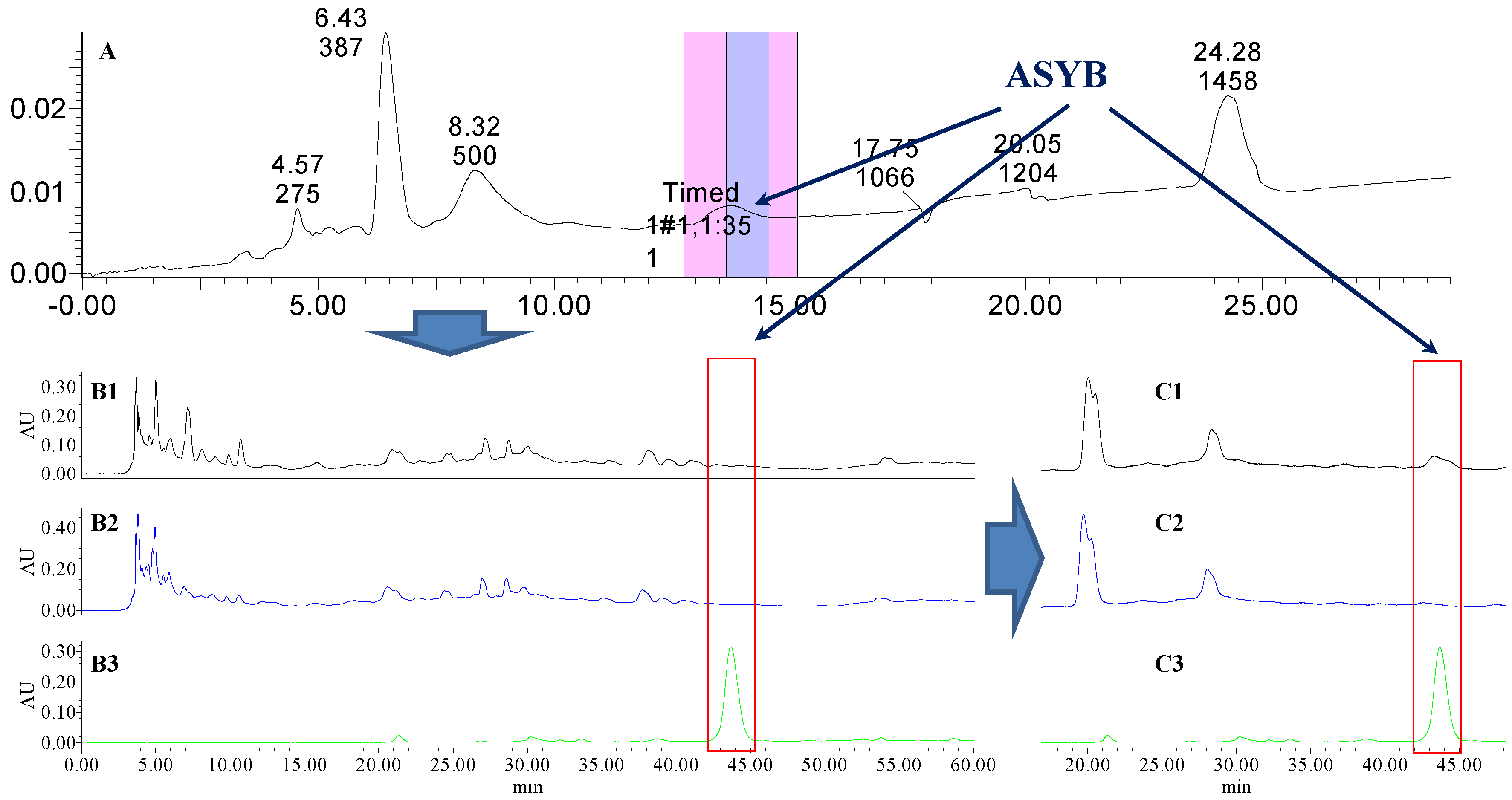
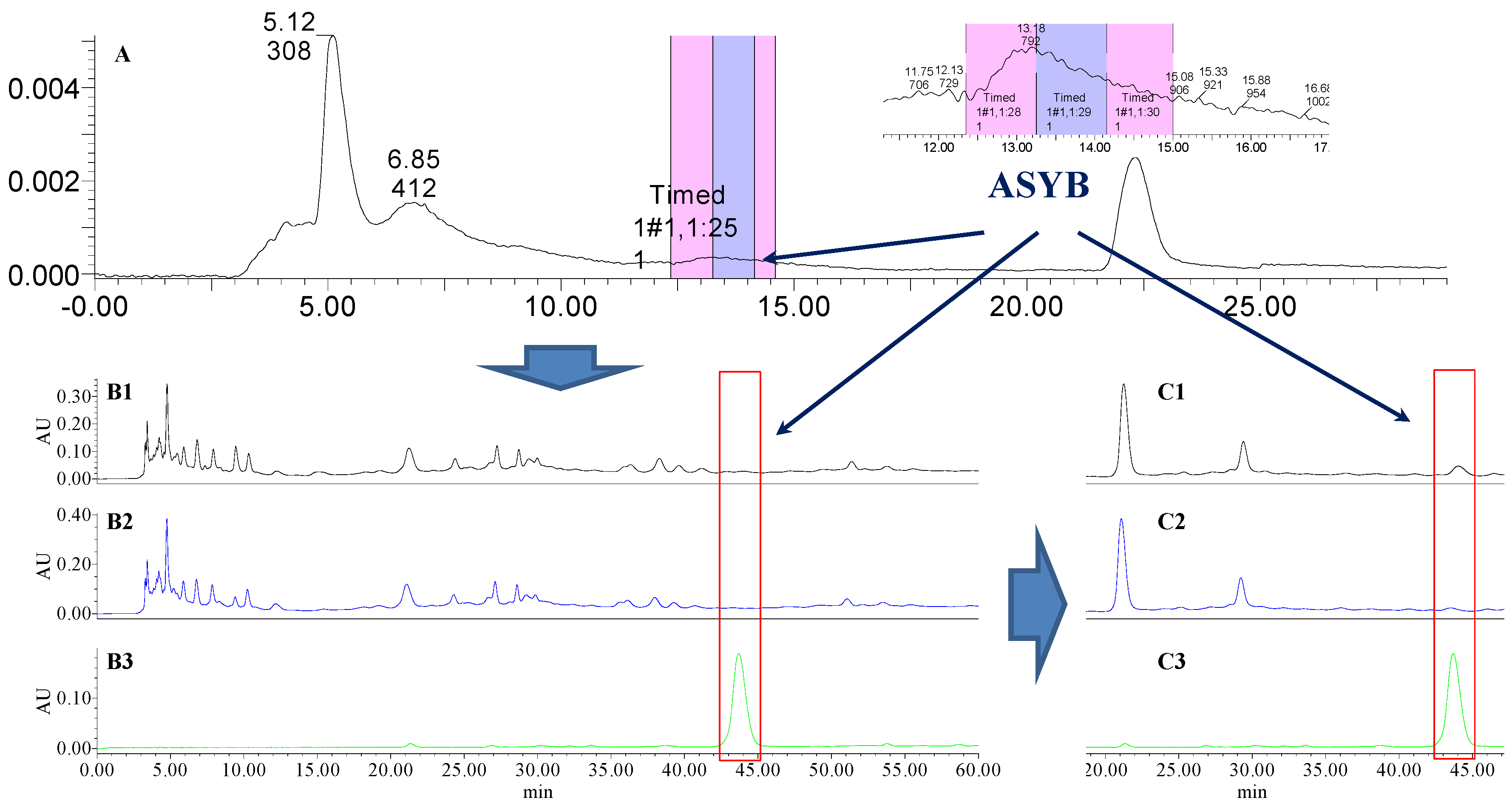
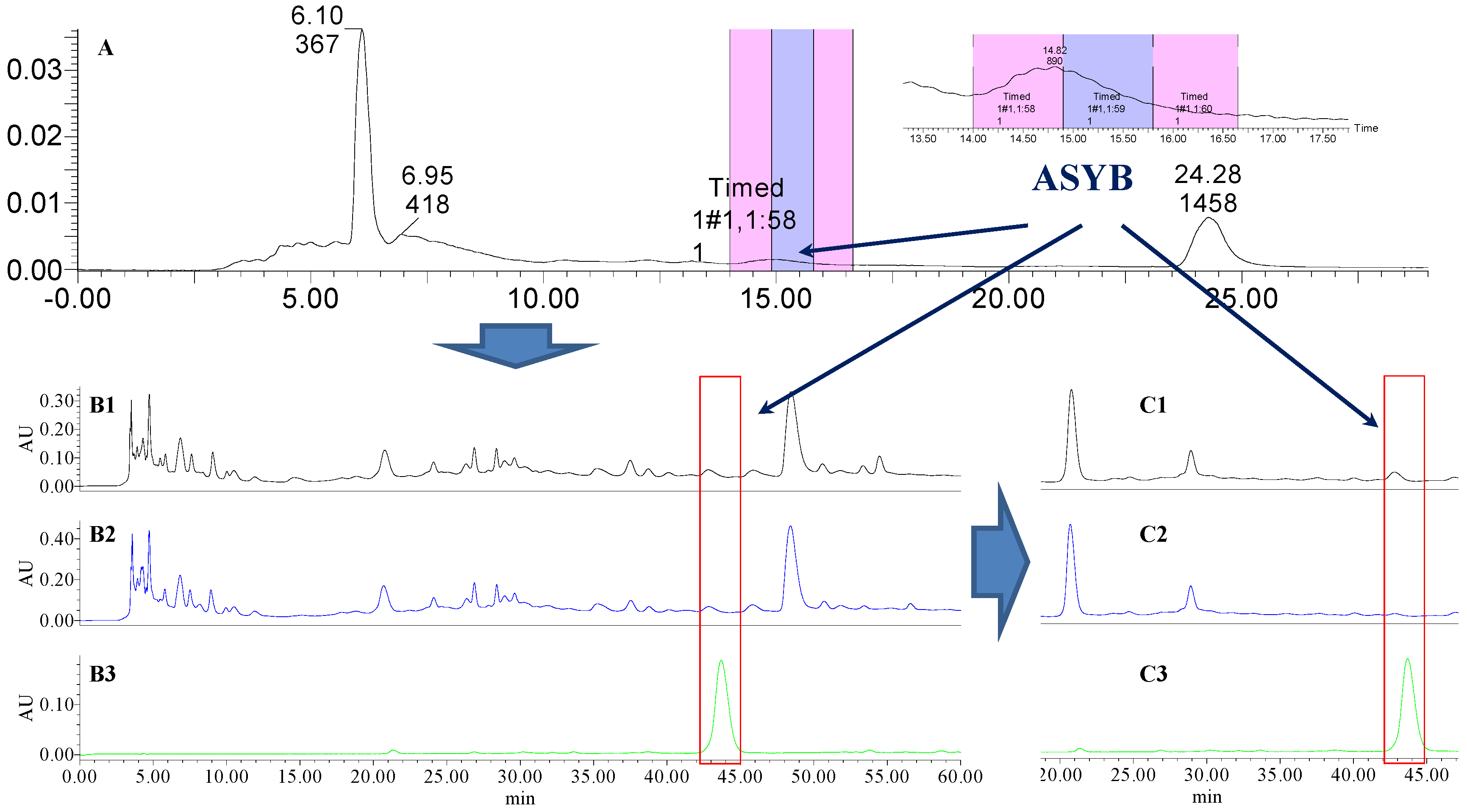

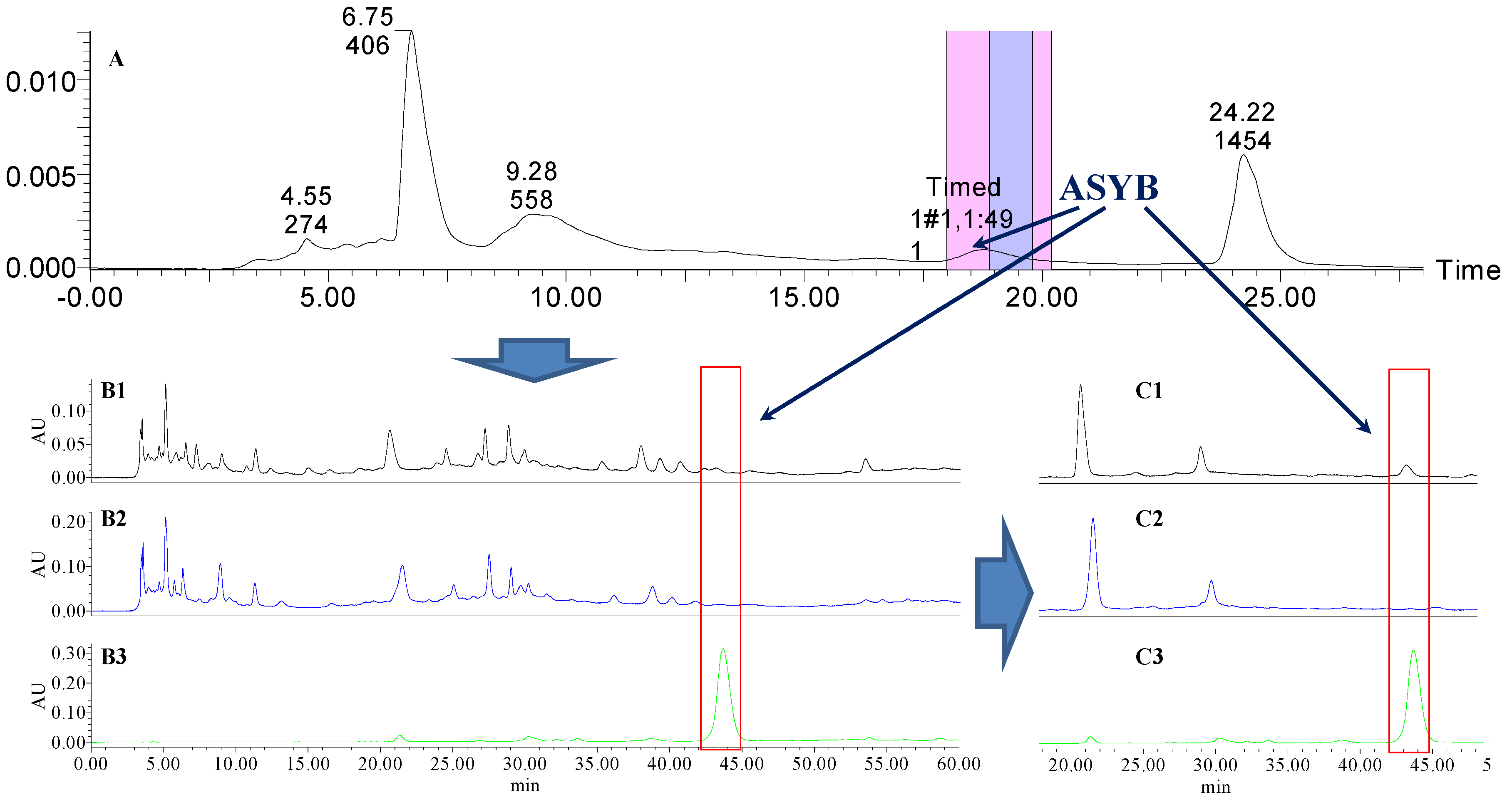
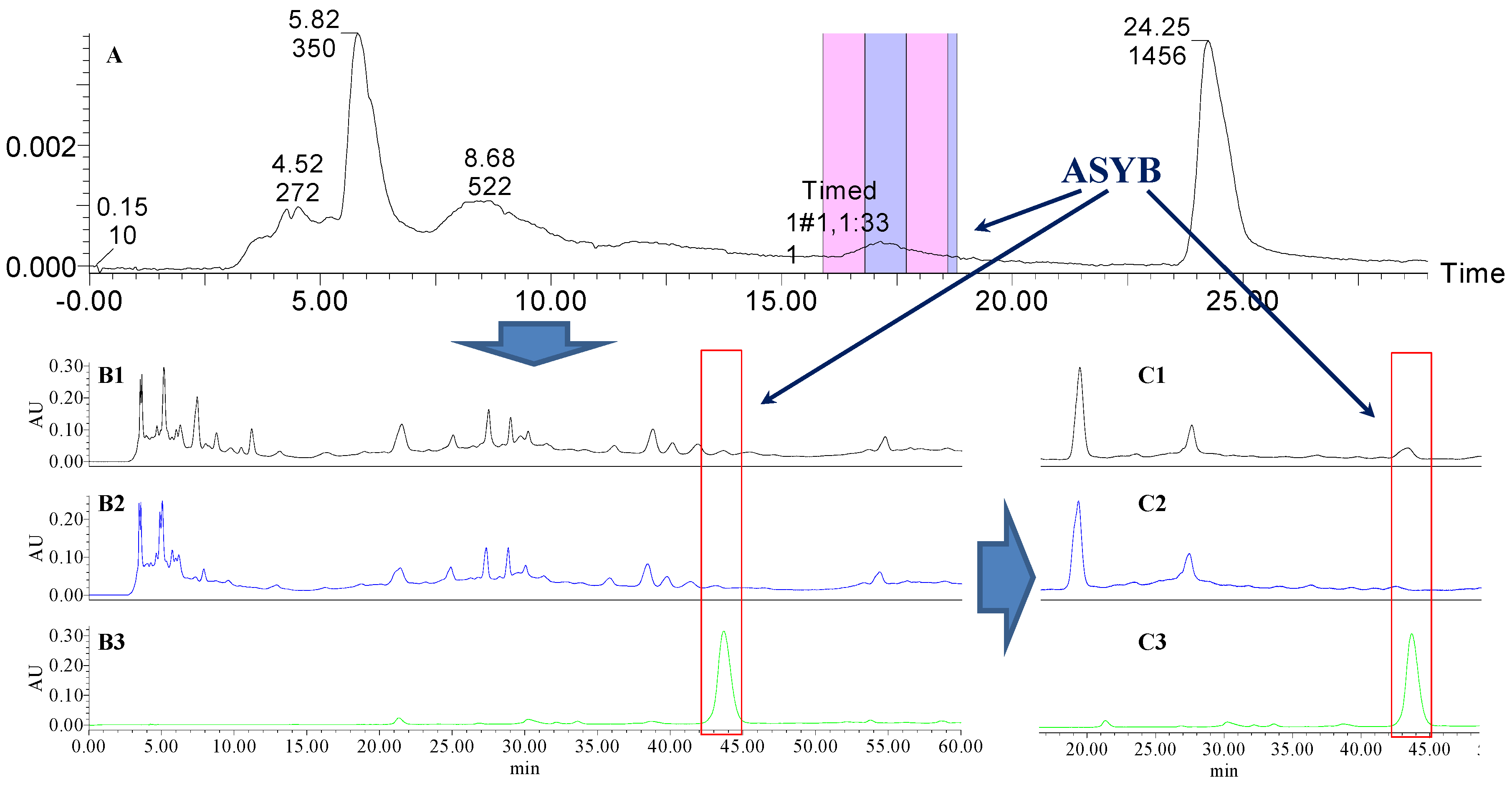
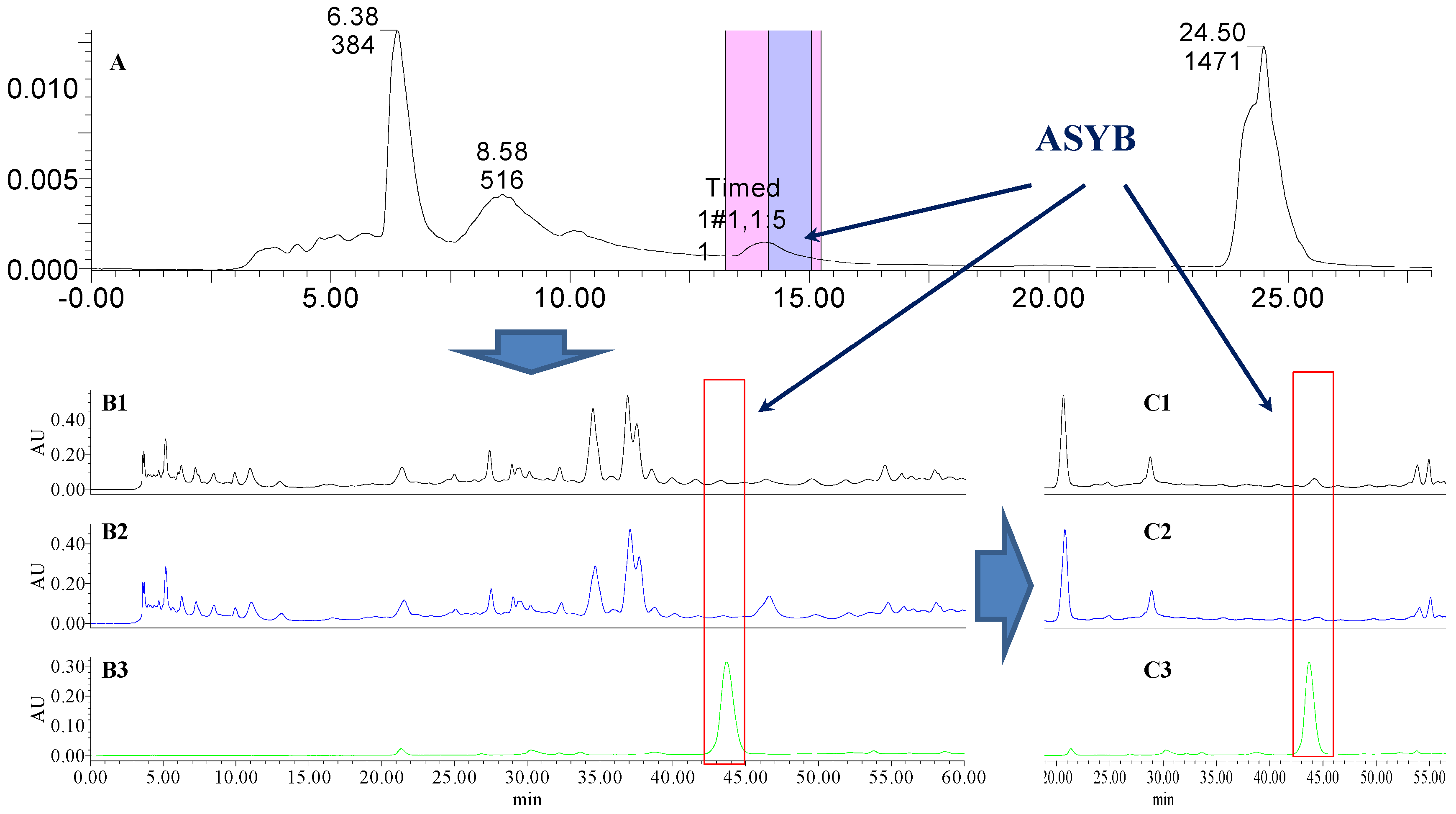
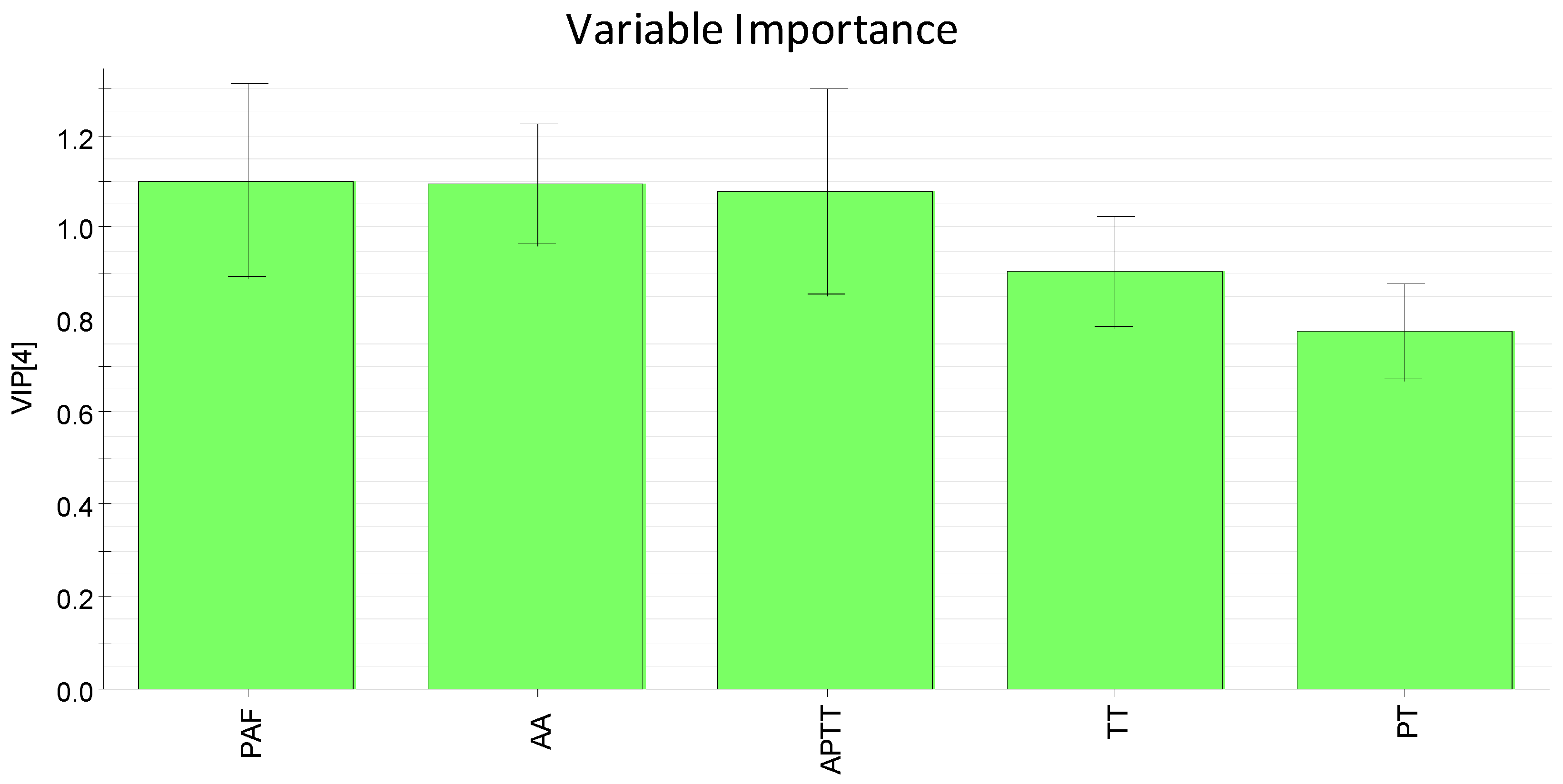
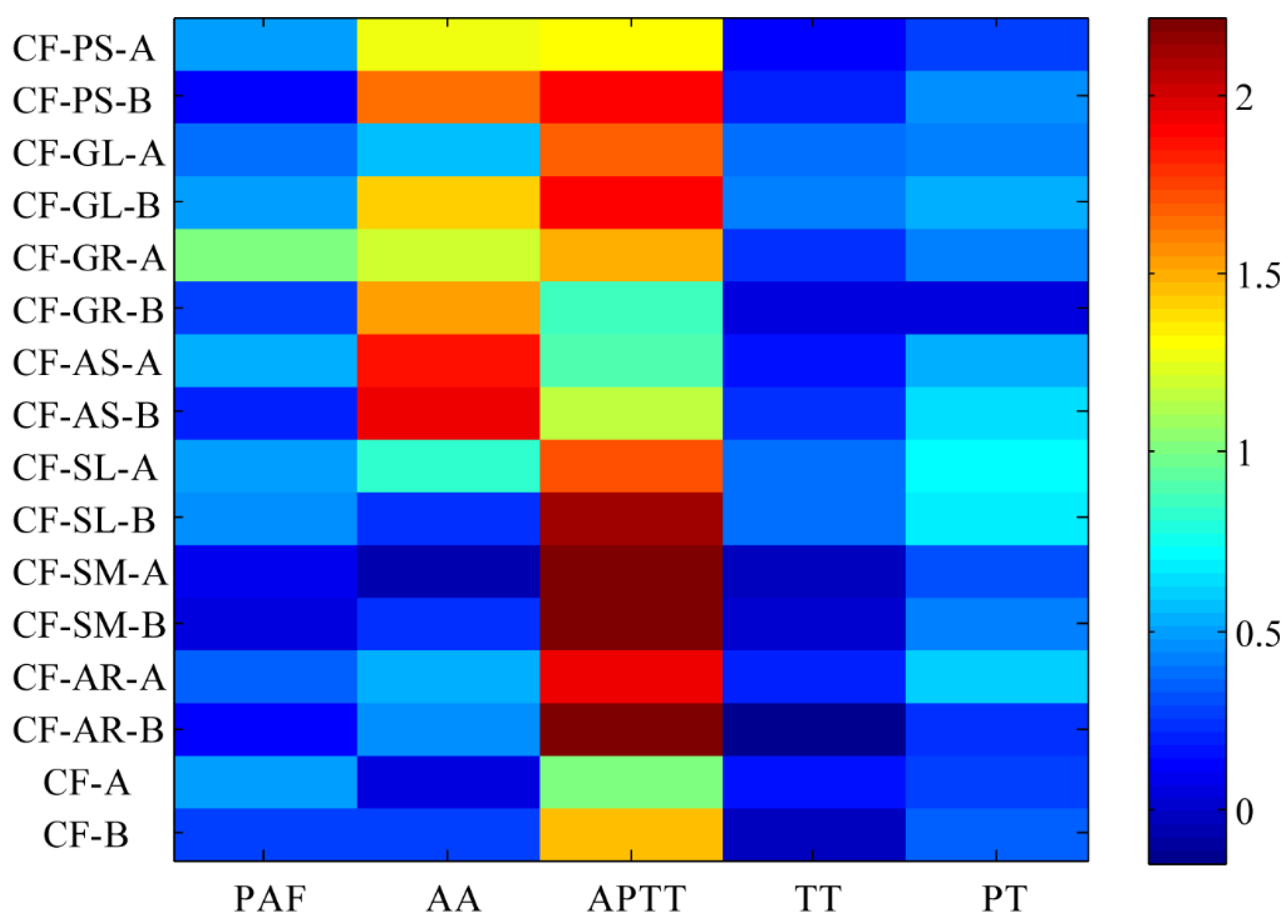
| Group | Aggregation Ratio (%) | Aggregation Inhibition Ratio (%) | Contribution Degree (%) |
|---|---|---|---|
| Negative control | 85.83 ± 4.70 | — | — |
| Positive control | 45.65 ± 1.78 ** | 46.81 ± 5.33 | — |
| HSYA | 72.40 ± 7.18 * | 15.64 ± 8.37 | — |
| ASYB | 54.35 ± 12.31 ** | 36.67 ± 14.34 | — |
| CF | 33.08 ± 3.43 ** | 61.46 ± 4.00 | — |
| CF-A | 46.48 ± 6.66 **△ | 45.85 ± 7.76 | 25.40 |
| CF-B | 40.55 ± 3.52 **△ | 52.75 ± 4.10 | 14.17 |
| CF-PS | 51.00 ± 4.07 ** | 40.58 ± 4.74 | — |
| CF-PS-A | 59.45 ± 5.53 **△ | 30.73 ± 6.44 | 24.26 |
| CF-PS-B | 53.47 ± 3.35 ** | 37.70 ± 3.91 | — |
| CF-GL | 46.83 ± 3.68 ** | 45.44 ± 4.28 | — |
| CF-GL-A | 54.30 ± 5.28 ** | 36.73 ± 6.15 | — |
| CF-GL-B | 56.25 ± 7.50 ** | 34.46 ± 8.74 | — |
| CF-GR | 18.28 ± 4.04 ** | 78.71 ± 4.71 | — |
| CF-GR-A | 53.18 ± 10.34 **△△ | 38.04 ± 12.05 | 51.67 |
| CF-GR-B | 27.25 ± 5.57 **△ | 68.25 ± 6.49 | 13.29 |
| CF-AS | 11.95 ± 5.57 ** | 86.08 ± 2.58 | — |
| CF-AS-A | 31.08 ± 2.65 **△△ | 63.79 ± 3.06 | 25.89 |
| CF-AS-B | 18.73 ± 4.82 **△ | 78.18 ± 5.62 | 9.17 |
| CF-SL | 36.45 ± 4.42 ** | 57.53 ± 5.16 | — |
| CF-SL-A | 48.78 ± 5.72 **△ | 43.17 ± 6.66 | 24.96 |
| CF-SL-B | 47.53 ± 6.17 **△ | 44.63 ± 7.19 | 22.43 |
| CF-SM | 25.60 ± 6.53 ** | 70.17 ± 7.61 | — |
| CF-SM-A | 28.45 ± 6.27 ** | 66.85 ± 7.31 | — |
| CF-SM-B | 27.03 ± 4.35 ** | 68.51 ± 5.07 | — |
| CF-AR | 28.98 ± 5.71 ** | 66.24 ± 6.65 | — |
| CF-AR-A | 38.53 ± 3.70 **△ | 55.11 ± 4.31 | 16.80 |
| CF-AR-B | 32.65 ± 6.06 ** | 61.96 ± 7.06 | — |
| Group | Aggregation Ratio (%) | Aggregation Inhibition Ratio (%) | Contribution Degree (%) |
|---|---|---|---|
| Negative control | 78.38 ± 8.66 | — | — |
| Positive control | 58.23 ± 5.45 ** | 25.71 ± 3.44 | — |
| HSYA | 71.25 ± 2.12 | 9.09 ± 2.71 | — |
| ASYB | 73.15 ± 2.44 | 6.67 ± 3.11 | — |
| CF | 11.15 ± 2.14 ** | 85.77 ± 2.73 | — |
| CF-A | 12.78 ± 2.86 **△ | 83.70 ± 3.65 | 4.89 |
| CF-B | 20.25 ± 2.23 **△△ | 74.16 ± 2.85 | 9.43 |
| CF-PS | 11.04 ± 3.25 ** | 55.02 ± 14.09 | — |
| CF-PS-A | 63.07 ± 7.75 *△△ | 19.53 ± 2.70 | 64.50 |
| CF-PS-B | 70.75 ± 2.43 △△ | 9.73 ± 3.10 | 82.32 |
| CF-GL | 14.78 ± 7.52 ** | 81.15 ± 9.60 | — |
| CF-GL-A | 32.45 ± 5.55 **△△ | 58.60 ± 7.08 | 27.79 |
| CF-GL-B | 59.60 ± 2.61 **△△ | 23.96 ± 3.33 | 70.48 |
| CF-GR | 42.22 ± 2.72 ** | 30.24 ± 4.50 | — |
| CF-GR-A | 53.18 ± 6.10 △ | 12.14 ± 10.08 | 59.84 |
| CF-GR-B | 56.28 ± 3.20 △△ | 7.02 ± 5.28 | 76.78 |
| CF-AS | 37.82 ± 2.85 ** | 37.50 ± 4.71 | — |
| CF-AS-A | 59.22 ± 5.00 △△ | 2.15 ± 8.26 | 94.27 |
| CF-AS-B | 59.82 ± 6.66 △△ | 1.16 ± 11.00 | 96.92 |
| CF-SL | 51.67 ± 0.91 ** | 34.08 ± 1.16 | — |
| CF-SL-A | 62.87 ± 2.48 *△△ | 19.79 ± 3.17 | 41.93 |
| CF-SL-B | 54.77 ± 2.50 ** | 30.12 ± 3.19 | — |
| CF-SM | 28.30 ± 3.35 ** | 63.89 ± 4.28 | — |
| CF-SM-A | 26.83 ± 3.61 ** | 65.77 ± 4.61 | — |
| CF-SM-B | 33.93 ± 4.14 ** | 56.71 ± 5.29 | — |
| CF-AR | 27.40 ± 7.36 ** | 65.04 ± 9.39 | — |
| CF-AR-A | 40.83 ± 4.40 **△ | 47.90 ± 5.62 | 26.35 |
| CF-AR-B | 39.22 ± 3.55 **△ | 50.41 ± 4.49 | 28.75 |
| Group | TT | PT | APTT | |||
|---|---|---|---|---|---|---|
| t (s) | Contribution Degree (%) | t (s) | Contribution Degree (%) | t (s) | Contribution Degree (%) | |
| Negative control | 13.60 ± 0.50 | — | 9.65 ± 0.24 | — | 14.28 ± 0.22 | — |
| Positive control | 15.56 ± 1.22 ** | — | 14.08 ± 1.48 ** | — | 16.38 ± 0.54 ** | |
| HSYA | 15.15 ± 1.24 | — | 9.70 ± 0.24 | — | 14.13 ± 0.59 | — |
| ASYB | 13.75 ± 0.38 | — | 9.38 ± 0.70 | — | 14.25 ± 0.29 | — |
| CF | 45.30 ± 2.02 ** | — | 34.93 ± 2.19 ** | — | 71.40 ± 3.27 ** | — |
| CF-A | 40.05 ± 2.21 ** | 16.56 | 28.35 ± 0.88 **△△ | 26.03 | 42.68 ± 0.61 **△△ | 50.28 |
| CF-B | 45.83 ± 1.51 ** | — | 26.28 ± 1.78 **△△ | 34.22 | 29.90 ± 3.47 **△△ | 72.65 |
| CF-PS | 30.78 ± 1.01 ** | — | 18.23 ± 0.15 ** | — | 32.15 ± 3.45 ** | — |
| CF-PS-A | 28.40 ± 1.76 ** | — | 15.80 ± 0.26 **△△ | 28.32 | 20.30 ± 1.02 **△△ | 66.31 |
| CF-PS-B | 27.48 ± 2.50 **△ | 19.21 | 14.18 ± 0.15 **△△ | 47.20 | 15.20 ± 0.18 **△△ | 94.85 |
| CF-GL | 122.88 ± 27.26 ** | — | 153.7 ± 2.08 ** | — | 70.18 ± 9.82 ** | — |
| CF-GL-A | 81.13 ± 7.03 **△△ | 38.20 | 92.43 ± 4.72 **△△ | 42.53 | 22.68 ± 0.67 **△△ | 84.97 |
| CF-GL-B | 77.65 ± 3.64 **△△ | 41.39 | 77.40 ± 1.81 **△△ | 52.97 | 17.40 ± 1.92*△△ | 94.42 |
| CF-GR | 37.60 ± 0.96 ** | — | 25.53 ± 0.79 ** | — | 71.90 ± 4.58 ** | — |
| CF-GR-A | 32.05 ± 2.16 **△△ | 23.13 | 18.83 ± 1.05 **△△ | 42.19 | 28.80 ± 1.25 **△△ | 74.80 |
| CF-GR-B | 36.43 ± 4.02 ** | — | 24.95 ± 3.75 ** | — | 47.25 ± 5.96 **△△ | 42.78 |
| CF-AS | 52.80 ± 3.98 ** | — | 112.38 ± 14.81 ** | — | 97.38 ± 4.07 ** | — |
| CF-AS-A | 46.95 ± 0.48 **△ | 11.08 | 57.90 ± 1.93 **△△ | 53.03 | 59.85 ± 4.85 **△△ | 45.16 |
| CF-AS-B | 43.05 ± 4.11 **△ | 18.46 | 44.93 ± 0.52 **△△ | 65.66 | 49.70 ± 1.80 **△△ | 57.38 |
| CF-SL | 22.20 ± 0.71 ** | — | 15.40 ± 0.73 ** | — | 24.53 ± 2.68 ** | — |
| CF-SL-A | 18.98 ± 0.46 **△△ | 14.92 | 11.25 ± 0.26 **△△ | 72.77 | 15.70 ± 0.70 **△△ | 86.15 |
| CF-SL-B | 18.80 ± 0.29 **△△ | 24.87 | 11.40 ± 0.20 **△△ | 69.57 | 13.60 ± 0.39*△△ | 106.6 |
| CF-SM | 64.68 ± 14.47 ** | — | 62.57 ± 8.88 ** | — | 26.70 ± 2.73 ** | — |
| CF-SM-A | 65.08 ± 6.96 ** | — | 47.00 ± 4.53 ** | — | 12.91 ± 0.67 **△△ | 111.0 |
| CF-SM-B | 64.60 ± 9.01 ** | — | 41.10 ± 1.41 **△ | 40.57 | 13.10 ± 2.36△△ | 109.5 |
| CF-AR | 29.35 ± 1.52 ** | — | 19.68 ± 0.52 ** | — | 24.45 ± 2.59 ** | — |
| CF-AR-A | 25.90 ± 1.52 ** | — | 13.75 ± 0.13 **△△ | 59.12 | 14.53 ± 0.69△△ | 97.54 |
| CF-AR-B | 31.73 ± 1.50 ** | — | 17.28 ± 0.36 **△△ | 23.97 | 13.30 ± 0.67*△△ | 109.6 |
| Group | Vsa | Vsb | Total Contribution Value of Activating Blood (2a + b) | |||
|---|---|---|---|---|---|---|
| PAF | AA | APTT | TT | PT | ||
| CF-PS-A | 0.2427 | 0.6450 | 0.6631 | 0.1385 | 0.2832 | 3.5235 |
| CF-PS-B | 0.0710 | 0.8232 | 0.9485 | 0.1921 | 0.4720 | 4.3494 |
| CF-GL-A | 0.1917 | 0.2779 | 0.8497 | 0.3820 | 0.4253 | 3.4460 |
| CF-GL-B | 0.2416 | 0.7047 | 0.9442 | 0.4139 | 0.5297 | 4.7247 |
| CF-GR-A | 0.5167 | 0.5985 | 0.7480 | 0.2313 | 0.4219 | 4.3797 |
| CF-GR-B | 0.1329 | 0.7679 | 0.4278 | 0.0488 | 0.0365 | 2.7424 |
| CF-AS-A | 0.2589 | 0.9427 | 0.4516 | 0.1492 | 0.5303 | 3.9860 |
| CF-AS-B | 0.0918 | 0.9691 | 0.5738 | 0.2487 | 0.6566 | 4.1745 |
| CF-SL-A | 0.2496 | 0.4193 | 0.8615 | 0.3744 | 0.7217 | 4.1569 |
| CF-SL-B | 0.2242 | 0.1162 | 1.0663 | 0.3953 | 0.6957 | 3.9045 |
| CF-SM-A | 0.0473 | −0.0294 | 1.1103 | −0.0078 | 0.2942 | 2.5428 |
| CF-SM-B | 0.0237 | 0.1124 | 1.0950 | 0.0016 | 0.4057 | 2.8694 |
| CF-AR-A | 0.1680 | 0.2635 | 0.9754 | 0.2190 | 0.5912 | 3.6242 |
| CF-AR-B | 0.0646 | 0.2249 | 1.0964 | −0.1511 | 0.2393 | 2.8600 |
| CF-A | 0.2540 | 0.0241 | 0.5028 | 0.1656 | 0.2603 | 1.9877 |
| CF-B | 0.1417 | 0.1354 | 0.7265 | −0.0167 | 0.3422 | 2.3327 |
© 2016 by the authors. Licensee MDPI, Basel, Switzerland. This article is an open access article distributed under the terms and conditions of the Creative Commons Attribution (CC-BY) license ( http://creativecommons.org/licenses/by/4.0/).
Share and Cite
Qu, C.; Wang, L.-Y.; Jin, W.-T.; Tang, Y.-P.; Jin, Y.; Shi, X.-Q.; Shang, L.-L.; Shang, E.-X.; Duan, J.-A. Comparative Analysis of the Effects of Hydroxysafflor Yellow A and Anhydrosafflor Yellow B in Safflower Series of Herb Pairs Using Prep-HPLC and a Selective Knock-Out Approach. Molecules 2016, 21, 1480. https://doi.org/10.3390/molecules21111480
Qu C, Wang L-Y, Jin W-T, Tang Y-P, Jin Y, Shi X-Q, Shang L-L, Shang E-X, Duan J-A. Comparative Analysis of the Effects of Hydroxysafflor Yellow A and Anhydrosafflor Yellow B in Safflower Series of Herb Pairs Using Prep-HPLC and a Selective Knock-Out Approach. Molecules. 2016; 21(11):1480. https://doi.org/10.3390/molecules21111480
Chicago/Turabian StyleQu, Cheng, Lin-Yan Wang, Wen-Tao Jin, Yu-Ping Tang, Yi Jin, Xu-Qin Shi, Li-Li Shang, Er-Xin Shang, and Jin-Ao Duan. 2016. "Comparative Analysis of the Effects of Hydroxysafflor Yellow A and Anhydrosafflor Yellow B in Safflower Series of Herb Pairs Using Prep-HPLC and a Selective Knock-Out Approach" Molecules 21, no. 11: 1480. https://doi.org/10.3390/molecules21111480
APA StyleQu, C., Wang, L.-Y., Jin, W.-T., Tang, Y.-P., Jin, Y., Shi, X.-Q., Shang, L.-L., Shang, E.-X., & Duan, J.-A. (2016). Comparative Analysis of the Effects of Hydroxysafflor Yellow A and Anhydrosafflor Yellow B in Safflower Series of Herb Pairs Using Prep-HPLC and a Selective Knock-Out Approach. Molecules, 21(11), 1480. https://doi.org/10.3390/molecules21111480






